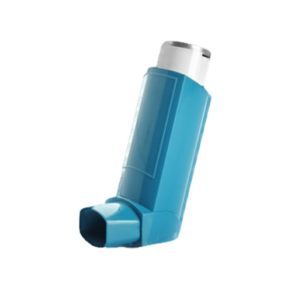Have you ever thought about how your medications can contribute to climate change?
In this post we are going to focus on how one class of medications that release greenhouse gasses and how we can decrease their impact on our environment. We will explore how one common inhaler can have the equivalent impact of driving 100km or further in a car, and how this impact can be minimized.
What are metered dose inhalers?
The most common type of inhalers used are metered dose inhalers. Metered dose inhalers are used for all types of medications from short acting medications that help relieve an asthma attack to longer acting medications used to prevent attacks. They are also used for other medications that can help with COPD and other lung conditions.
How do they work?
These types of inhalers work by pushing down on a metal canister filled with medication which is released with a compressed gas. This gas used to be a CFC which have since been banned due to their effect on the ozone layer and are replaced with a hydrofluorocarbon gas. This gas is a greenhouse gas which is much more potent than CO2.
Each time a metered dose inhalers is used a small amount of this gas is released. The amount of gas released with each dose is quite small, however, these are commonly prescribed medications so if we add all the doses together it becomes significant. In fact, this type of emission has been estimated to account for 0.03% of global emissions.
Try the following links to see how different puffers work:
Do all inhalers release this gas?
Not all inhalers release greenhouse gasses. Some are called dry powder inhalers and are sometimes known as a turbuhaler or diskus inhaler. These inhalers may be an option depending on your current treatment goals and health. These inhalers don’t contain any compressed gas or propellants. When you breath in through the mouthpiece a dry powder gets inhaled deep into the lungs. Another form of inhaler called a respimat uses a mist and no greenhouse gas is released.
What is the impact?
A study in the UK found that the average Ventolin inhaler(a type of metered dose inhaler commonly used for asthma and COPD) had a carbon footprint around 25 kg of CO2. When this is used in the EPA’s greenhouse gas calculator we find that this is the equivalent of driving 100km in a car.
So how can this effect be minimized?
We know you can’t stop using life saving medications, but there are ways to mitigate harm to the environment.
1. Return your old inhalers to the pharmacy for disposal. Even when incinerated there are less potent greenhouse gasses that are released from the inhalers.
2. Review how to use your inhaler. Using your inhaler correctly can decrease how often you need to use your inhaler, or refill your prescription.
3. If you are interested you can speak to our team or your primary care provider’s office about equivalent inhalers that do not use propellant gas.
What are the alternatives?
If you are interested in finding out if your current inhaler comes as a dry powder version get in touch with us today. Also, if you have questions about proper disposal of inhalers please reach out to one of our pharmacists. Call or text us at 519-954-1055 or send us an email at pharmacist@apothecarepharmacy.ca



0 Comments